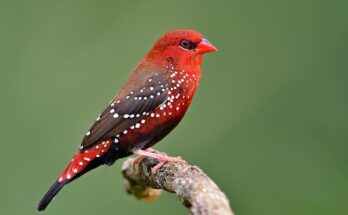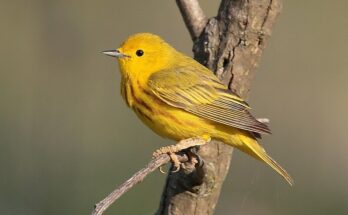Michigan is home to a fascinating variety of black birds, each with its own unique characteristics and habits. Some of these birds are common sights throughout the state, while others are more elusive, only appearing during migration seasons. In this article, we’ll explore 16 types of black birds you can find in Michigan, discussing their scientific names, sizes, diets, and more. These birds are not just plain black; they are often marked with vibrant colors and patterns, making them even more interesting to observe. Let’s take a closer look!
Here we’ll Learn about 10 Different Types of Black Birds Found in Michigan!
1. Red-winged Blackbird
- Scientific Name: Agelaius phoeniceus
- Size: 19–23 cm (7.5–9 in)
- Weight: 40–77 g (1.4–2.7 oz)
- Lifespan: Up to 15 years
- Diet: Seeds, insects, and fruits
If you ever find yourself near a marsh, wetland, or lake in Michigan, chances are you’ll hear the familiar call of the red-winged blackbird. With its glossy black feathers and distinctive red shoulder patches, the red-winged blackbird is one of the most commonly spotted blackbirds in the state.
If you’re near a marsh, wetland, or lake in Michigan, you might hear the familiar call of the red-winged blackbird.
With its glossy black feathers and distinctive red shoulder patches, the red-winged blackbird is one of the most commonly spotted blackbirds in the state.
What Do They Eat?
These birds have a diverse diet consisting of:
- Insects
- Seeds
- Grains
Where to Find Them?
They’re often perched on:
- Cattails
- Sedges
- Grasses
in marshes and wetlands, creating a stunning sight against the water.
Breeding Season
During breeding season, males will:
- Establish territories
- Flash their red patches to attract females
Meanwhile, females build nests out of grasses, weaving them into cattails or bushes over the water.
Protecting Their Young
Once the eggs are laid and hatched, males will:
- Feed their young
- Protect them from predators
- Work together with other males to chase away threats
How to Spot Them?
If you’re looking to spot a red-winged blackbird in Michigan, keep an eye out for its distinctive flight pattern:
- Rising steeply
- Dropping quickly
The best time to see them is during the spring and early summer months when males are establishing their territories.
2. Rusty Blackbird
- Scientific Name: Euphagus carolinus
- Size: 8-9 inches
- Weight: 2.1-2.7 oz
- Lifespan: Up to 9 years
- Diet: Insects, seeds, small fish
The Rusty Blackbird is a migratory bird that passes through Michigan during the fall and spring. Its name comes from the rusty coloring seen in its plumage during the non-breeding season. Rusty Blackbirds are often found near wetlands, swamps, and marshes, where they forage for insects and other small prey in shallow waters. Unfortunately, this species has seen a dramatic population decline in recent years.
Since this blackbird is so rare, imagine what it would be like to treasure this rare natural beauty uniquely.
For example, Custom Necklaces. They can be carefully customized with high-quality materials to restore the mystery and elegance of the blackbird. Such a blackbird necklace is not only a reflection of personal hobbies and tastes but also a way to treasure good luck.
It is a meaningful gift whether for personal collection or given to relatives and friends who love nature.
These birds are migratory and mostly found in Michigan during the winter season. However, they can also be seen during their breeding seasons, which occur between March and June. Rusties, as some birders call them, are often found in wetlands, marshes, and swamps, where they forage for insects and berries.
Their dwindling population is likely due to habitat loss and degradation, so spotting one can be a rare and rewarding experience. Be sure to keep an eye out for these elusive birds on your next birdwatching trip in Michigan.
3. Common Grackle
- Scientific Name: Quiscalus quiscula
- Size: 11-13 inches
- Weight: 2.6-5 oz
- Lifespan: Up to 22 years
- Diet: Insects, small vertebrates, seeds
Common Grackles are large blackbirds with iridescent plumage that shines in shades of purple, blue, and green. They are often seen in large flocks, especially during the fall migration. Common Grackles are highly adaptable birds, living in a variety of habitats from forests to urban areas. Their diet is varied, including insects, small animals, and even garbage in human-populated areas.
4. European Starling
- Scientific Name: Sturnus vulgaris
- Size: 7.9 inches
- Weight: 2.1-3.4 oz
- Lifespan: Up to 15 years
- Diet: Insects, fruits, seeds
The European Starling is an invasive species introduced to North America in the 19th century. While not native to Michigan, these birds have thrived across the state. They are easily recognizable by their speckled black plumage and short, stubby tails. European Starlings are known for their ability to mimic sounds, including human speech, and they often form large, noisy flocks.
5. Brown-headed Cowbird
- Scientific Name: Molothrus ater
- Size: 7-8.7 inches
- Weight: 1.3-1.6 oz
- Lifespan: Up to 16 years
- Diet: Seeds, grains, insects
The Brown-headed Cowbird is unique among blackbirds due to its parasitic nesting behavior. Instead of building their own nests, female cowbirds lay their eggs in the nests of other birds, leaving them to raise the cowbird chicks. Males are easy to spot with their glossy black bodies and distinctive brown heads. These birds are often seen in open fields and near agricultural areas in Michigan.
6. Baltimore Oriole
- Scientific Name: Icterus galbula
- Size: 6.7-7.5 inches
- Weight: 1-1.4 oz
- Lifespan: Up to 11 years
- Diet: Insects, nectar, fruit
Baltimore Orioles are known for their striking orange and black plumage. While the males are more vibrant in color, both sexes are a welcome sight in Michigan during the summer months. They prefer wooded areas and can often be found near parks and gardens, where they build hanging, basket-like nests. These black and orange birds of michigan primarily feed on insects, but they also enjoy fruits and nectar, which makes them regular visitors to backyard feeders.
7. Orchard Oriole
- Scientific Name: Icterus spurius
- Size: 5.9-7.1 inches
- Weight: 0.6-1 oz
- Lifespan: Up to 12 years
- Diet: Insects, fruit, nectar
The Orchard Oriole is a smaller cousin of the Baltimore Oriole. Males have dark chestnut and black plumage, while females are greenish-yellow. They prefer to live in orchards, farms, and open woodlands, making them a bit less common in suburban areas. Orchard Orioles are highly active during the summer months in Michigan, and they feed primarily on insects and nectar.
8. Brewer’s Blackbird
- Scientific Name: Euphagus cyanocephalus
- Size: 8-10 inches
- Weight: 1.8-2.8 oz
- Lifespan: Up to 12 years
- Diet: Insects, grains, seeds
Brewer’s Blackbirds are small, social birds often seen in open fields and along the edges of forests. Males have glossy black plumage with a metallic sheen, while females are more muted brown. Brewer’s Blackbirds form large flocks and are commonly seen foraging on the ground for seeds and insects. They are adaptable birds, thriving in both rural and urban environments across Michigan.
9. Shiny Cowbird
- Scientific Name: Molothrus bonariensis
- Size: 7.1-8.7 inches
- Weight: 1.4-1.8 oz
- Lifespan: Up to 16 years
- Diet: Seeds, insects
The Shiny Cowbird, much like the Brown-headed Cowbird, is a parasitic nester. It lays its eggs in the nests of other bird species, relying on them to raise its young. This bird is native to South America but has been spotted occasionally in Michigan, mostly during migration. Males have glossy purple-black plumage, while females are duller in color. Though they are rare in Michigan, their presence is always a point of interest for birdwatchers.
10. Bullock’s Oriole
- Scientific Name: Icterus bullockii
- Size: 6.7-7.5 inches
- Weight: 1-1.5 oz
- Lifespan: Up to 10 years
- Diet: Insects, fruit, nectar
Bullock’s Orioles are more commonly found in the western United States, but they occasionally make their way to Michigan during migration. Males are bright orange with black wings, while females are more muted in color. These black birds of michigan build elaborate, hanging nests and feed on insects, fruits, and nectar. While not a regular visitor to Michigan, their appearance is always a pleasant surprise.
Attracting Black Birds to Your Backyard in Michigan
If you’re a bird enthusiast, attracting blackbirds to your backyard can be a rewarding experience. Blackbirds, such as the red-winged blackbird and common grackle, bring unique beauty and charm to your outdoor space. Here are some tips to help you attract blackbirds to your backyard in Michigan:
Provide a Variety of Bird Feeders
One great way to attract blackbirds to your backyard is by offering a variety of bird feeders. Fill your feeders with a mixture of seeds, fruits, and insects to provide black birds with a diverse and nutritious diet. You can also try offering suet feeders, which are especially popular among blackbirds.
Create Suitable Nesting Habitats
Blackbirds, like many bird species, require suitable nesting habitats to raise their young. You can create nesting habitats by providing birdhouses and nesting boxes that are appropriate for blackbirds. You can also try leaving out nesting materials, such as twigs, grass, and feathers, for blackbirds to use when building their nests.



